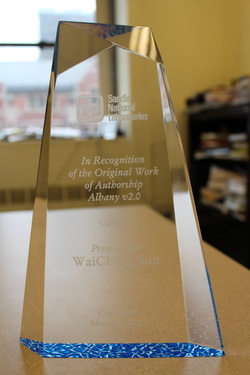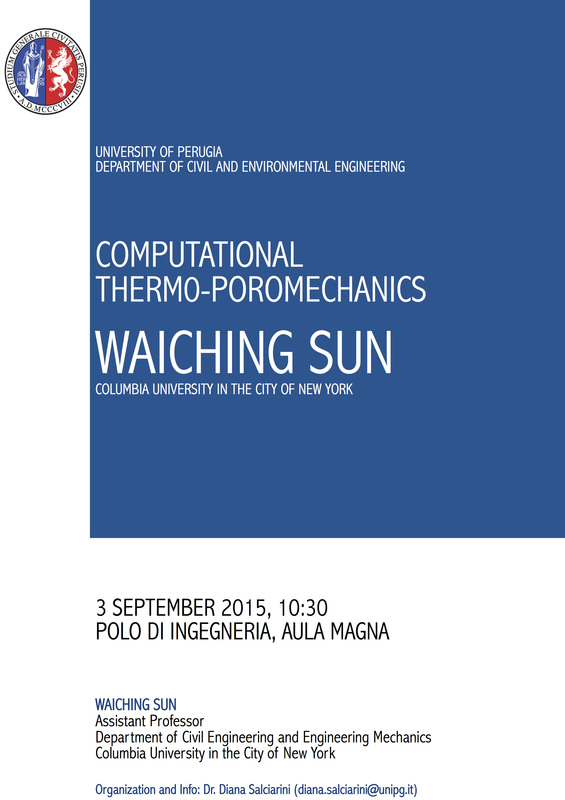|
A nonlocal multiscale discrete-continuum model for predicting mechanical behavior of granular materials
Yang Liu, WaiChing Sun,Zifeng Yuan, Jacob Fish Department of Civil Engineering and Engineering Mechanics, Columbia University, New York, NY 10027, USA SUMMARY A three-dimensional nonlocal multiscale discrete-continuum model has been developed for modeling mechanical behavior of granular materials. In the proposed multiscale scheme, we establish an information-passing coupling between the discrete element method (DEM), which explicitly replicates granular motion of individual particles, and a finite element continuum model, which captures nonlocal overall responses of the granular assemblies. The resulting multiscale discrete-continuum coupling method retains the simplicity and efficiency of a continuum-based finite element model, while circumventing mesh pathology in the post-bifurcation regime by means of staggered nonlocal operator. We demonstrate that the multiscale coupling scheme is able to capture the plastic dilatancy and pressure-sensitive frictional responses commonly observed inside dilatant shear bands, without employing a phenomenological plasticity model at a macroscopic level. In addition, internal variables, such as plastic dilatancy and plastic flow direction, are now inferred directly from granular physics, without introducing unnecessary empirical relations and phenomenology. The simple shear and the biaxial compression tests are used to analyze the onset and evolution of shear bands in granular materials and sensitivity to mesh density. The robustness and accuracy of the proposed multiscale model are verified in comparisons with single-scale benchmark DEM simulations. KEY WORDS: multiscale discrete-continuum model; staggered nonlocal operator; strain localization; granular materials; homogenization; shear band; anisotropy
0 Comments
Abstract
This work presents a new staggered multilevel material identification procedure for phenomenological critical state plasticity models. The emphasis is placed on cases in which available experimental data and constraints are insufficient for calibration. The key idea is to create a secondary virtual experimental database from high-fidelity models, such as discrete element simulations, then merge both the actual experimental data and secondary database as an extended digital database to determine material parameters for the phenomenological macroscopic critical state plasticity model. The calibration procedure therefore consists of two steps. First, the material parameters of the DEM simulations are identified via the standard optimization procedure. Then, the calibrated DEM simulations are used to expand the experimental database with new simulated loading histories. This expansion of database provides additional constraints necessary for calibration of the phenomenological critical state plasticity models. The robustness of the proposed material identification framework is demonstrated in the context of the Dafalias-Manzari plasticity model. URL: http://appliedmechanics.asmedigitalcollection.asme.org/article.aspx?articleid=2443823  Professor Sun received recognitions for his work as a part of the research team that develops Albany v2.0, a computational mechanics code developed by research staffs at Sandia National Laboratories and collaborators from Universities. The research project is lead by Dr. Andrew Salinger from Sandia National Laboratories. Dr. Sun’s involvement in this project includes the theoretical development and implementations of a number of finite strain models for poromechanics and thermo-hydro-mechanics problems, and the implementation of a hydrogen embrittlement model derived by his collaborators. Prof. Sun’s work on Albany has resulted in 6 journal articles [1-6], 5 of which he served as the first author. More information can be found in the publication listed below. 1. Mota, W.C. Sun, J.T.Ostein, J.W. Foulk III, K.N. Long, Lie-Group interpolation and variational recovery for internal variables, Computational Mechanics, 52:1281-1299, doi:10.1007/s00466-013-0876-1, 2013. [PDF] [Bibtex] 2. W.C. Sun, J.T. Ostien, A.G. Salinger, A stabilized assumed deformation gradient finite element formulation for strongly coupled poromechanical simulations at finite strain, International Journal for Numerical and Analytical Methods in Geomechanics, 37(16):2755-2788, doi:10.1002/nag.2161, 2013. [PDF] [Bibtex] 3. W.C. Sun, M.R. Kuhn and J.W.Rudnicki, A multiscale DEM-LBM analysis on permeability evolutions inside a dilatant shear band, Acta Geotechnica, 8(5):465-480, doi:10.1007/s11440-013-0210-2, 2013. (The authors received the Caterpillar Best paper prize in the year of 2013) [PDF] [Bibtex] 4. W.C. Sun, Q. Chen, J.T. Ostien, Modeling hydro-mechanical responses of strip and circular footings on saturated collapsible geomaterials, Acta Geotechnica, 9(5):903-934, doi:10.1007/s11440-013-0276-x, 2014. [PDF] [Bibtex] 5. W.C. Sun, A. Mota, A multiscale overlapped coupling formulation for large deformation strain localization, Computational Mechanics, 54(3):803-820, doi: 10.1007/s00466-014-1034-0, 2014. [PDF] [Bibtex] [Erratum] 6. W.C. Sun, A stabilized finite element formulation for monolithic thermo-hydro-mechanical simulations at finite strain, International Journal for Numerical Methods in Engineering, 103(11):798-839, doi:10.1002/nme.4910, 2015. [PDF] [Bibtex] |
Group NewsNews about Computational Poromechanics lab at Columbia University. Categories
All
Archives
July 2023
|


 RSS Feed
RSS Feed